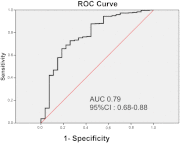Utility of PTEN protein dosage in predicting for underlying germline PTEN mutations among patients presenting with thyroid cancer and Cowden-like phenotypes
- PMID: 23066114
- PMCID: PMC3513537
- DOI: 10.1210/jc.2012-2944
Utility of PTEN protein dosage in predicting for underlying germline PTEN mutations among patients presenting with thyroid cancer and Cowden-like phenotypes
Abstract
Context: Thyroid cancer is a major component of Cowden syndrome (CS). CS patients with an underlying PTEN mutation (PTEN(mut+)) have a 70-fold increased risk of developing epithelial thyroid cancer. In contrast, less than 1% of sporadic epithelial thyroid cancer patients carry a germline PTEN mutation. Cost-efficient markers capable of shortlisting thyroid cancers for CS genetic testing would be clinically useful.
Objective: Our objective was to analyze the utility of patient blood phosphate and tensin homolog deleted on chromosome 10 (PTEN) protein levels in predicting germline PTEN mutations.
Design, setting, and patients: We conducted a 5-yr, multicenter prospective study of 2792 CS and CS-like patients, all of whom had comprehensive PTEN analysis. Analysis of PTEN and downstream proteins by immunoblotting was performed on total protein lysates from patient-derived lymphoblast lines. We compared blood PTEN protein levels between PTEN(mut+) patients and those with variants of unknown significance or wild-type PTEN (PTEN(wt/vus)).
Main outcome measures: We assessed the utility of PTEN protein levels in predicting germline PTEN mutations.
Results: Of 2792 CS/CS-like patients, 721 patients had thyroid cancer; 582 of them (81%) had blood PTEN protein analyzed. PTEN germline pathogenic mutations were present in 27 of 582 patients (4.6%). Ninety-six percent (26 of 27) of PTEN(mut+) patients had blood PTEN protein levels in the lowest quartile as compared with 25% (139 of 555) of PTEN(wt/vus) patients (P < 0.001). Low blood PTEN levels predicted for PTEN(mut+) cases with a 99.76% negative predictive value (95% confidence interval = 98.67-99.96) and a positive test likelihood ratio of 3.84 (95% confidence interval = 3.27-4.52).
Conclusions: Our study shows that low blood PTEN protein expression could serve as a screening molecular correlate to predict for germline PTEN mutation in CS and CS-like presentations of thyroid cancer.
Figures




Similar articles
-
Germline alterations in RASAL1 in Cowden syndrome patients presenting with follicular thyroid cancer and in individuals with apparently sporadic epithelial thyroid cancer.J Clin Endocrinol Metab. 2014 Jul;99(7):E1316-21. doi: 10.1210/jc.2014-1225. Epub 2014 Apr 8. J Clin Endocrinol Metab. 2014. PMID: 24712574 Free PMC article.
-
Incidence and clinical characteristics of thyroid cancer in prospective series of individuals with Cowden and Cowden-like syndrome characterized by germline PTEN, SDH, or KLLN alterations.J Clin Endocrinol Metab. 2011 Dec;96(12):E2063-71. doi: 10.1210/jc.2011-1616. Epub 2011 Sep 28. J Clin Endocrinol Metab. 2011. PMID: 21956414 Free PMC article.
-
PTEN lipid phosphatase activity and proper subcellular localization are necessary and sufficient for down-regulating AKT phosphorylation in the nucleus in Cowden syndrome.J Clin Endocrinol Metab. 2012 Nov;97(11):E2179-87. doi: 10.1210/jc.2012-1991. Epub 2012 Sep 7. J Clin Endocrinol Metab. 2012. PMID: 22962422 Free PMC article.
-
Breast cancer risk and clinical implications for germline PTEN mutation carriers.Breast Cancer Res Treat. 2017 Aug;165(1):1-8. doi: 10.1007/s10549-015-3665-z. Epub 2015 Dec 23. Breast Cancer Res Treat. 2017. PMID: 26700035 Review.
-
PTEN hamartoma tumor syndrome: clinical risk assessment and management protocol.Methods. 2015 May;77-78:11-9. doi: 10.1016/j.ymeth.2014.10.011. Epub 2014 Oct 22. Methods. 2015. PMID: 25461771 Review.
Cited by
-
PTEN-opathies: from biological insights to evidence-based precision medicine.J Clin Invest. 2019 Feb 1;129(2):452-464. doi: 10.1172/JCI121277. Epub 2019 Jan 7. J Clin Invest. 2019. PMID: 30614812 Free PMC article. Review.
-
Precise Immunodetection of PTEN Protein in Human Neoplasia.Cold Spring Harb Perspect Med. 2019 Dec 2;9(12):a036293. doi: 10.1101/cshperspect.a036293. Cold Spring Harb Perspect Med. 2019. PMID: 31501265 Free PMC article. Review.
-
Integrating thousands of PTEN variant activity and abundance measurements reveals variant subgroups and new dominant negatives in cancers.Genome Med. 2021 Oct 14;13(1):165. doi: 10.1186/s13073-021-00984-x. Genome Med. 2021. PMID: 34649609 Free PMC article.
-
PTEN Inhibition in Human Disease Therapy.Molecules. 2018 Jan 30;23(2):285. doi: 10.3390/molecules23020285. Molecules. 2018. PMID: 29385737 Free PMC article. Review.
-
Looking at Thyroid Cancer from the Tumor-Suppressor Genes Point of View.Cancers (Basel). 2022 May 17;14(10):2461. doi: 10.3390/cancers14102461. Cancers (Basel). 2022. PMID: 35626065 Free PMC article. Review.
References
-
- Howlader N, Noone A, Krapcho M, Neyman N, Aminou R, Altekruse S, Kosary CL, Ruhl J, Tatalovich Z, Cho H, Mariotto A, Eisner M, Lewis D, Chen H, Feuer E, Cronin KA. 2012. SEER data submission SEER Cancer Statistics Review, 1975–2009 (vintage 2009 populations). Bethesda, MD: National Cancer Institute
-
- Ngeow J, Mester J, Rybicki LA, Ni Y, Milas M, Eng C. 2011. Incidence and clinical characteristics of thyroid cancer in prospective series of individuals with Cowden and Cowden-like syndrome characterized by germline PTEN, SDH, or KLLN alterations. J Clin Endocrinol Metab 96:E2063–E2071 - PMC - PubMed
-
- Zbuk KM, Eng C. 2007. Cancer phenomics: RET and PTEN as illustrative models. Nat Rev Cancer 7:35–45 - PubMed
Publication types
MeSH terms
Substances
Supplementary concepts
Grants and funding
LinkOut - more resources
Full Text Sources
Medical
Research Materials

